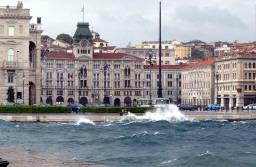Trieste, the northeastern Italian port which inspired Irish novelist James Joyce, will on Tuesday join cities around the world in paying homage to his greatest work.
The action of Joyce's Ulysses, recognised as the seminal work of literary modernism, is set on a single day in Dublin, June 16, 1904, and features protagonist Leopold Bloom's encounters with characters inspired by the Homeric hero's adventures.
Admirers of Joyce set up the first Bloomsday in Dublin on June 16, 1954 and the celebrations have since spread to several other cities including Trieste where Joyce, then a struggling English teacher, wrote the first part of his masterpiece and met major local writers Umberto Saba and Italo Svevo.
This year a Trieste cultural association, Daydreaming Project, has commissioned top local contemporary artist Guglielmo Manenti to paint a series of pictures portraying episodes of the novel.
Starting off from the Galleria Metrokubo, Manenti's Joyce trail will weave through the city's historic centre, where the novelist lived from 1904 until the First World War.
Galleries, bookshops, literary cafes and some of Joyce's old watering holes will host the paintings in what Daydreaming Project hopes will be ''an annual event in which contemporary art seeks to investigate a writer who holds a multiplicity of suggestions''.
Kicking off the tour, the curator of the city's Joyce Museum, Erik Schneider, will give a lecture entitled Joyce and Trieste's Brothels.
The American has devoted his life to conserving the memory of the Irish writer in the former Austrian Empire port whose knotty dialect is believed to have inspired some of the word play in Ulysses.
''Trieste is fundamental to Joyce,'' Schneider says.
Although most of Ulysses is based on memories of Dublin, Schneider says the shabby grandeur of the Italian city and its teeming poly-ethnic underclass of craftsmen, sailors, workmen and working girls fired the writer's imagination.
The town's former red-light district in Cittavecchia, believed to have been a prototype for the 'Nighttown' of Ulysses, is today a home to a large population of stray cats.
''Joyce prowled there too,'' Schneider says, crediting the writer's amorous encounters with laying the erotic seam that runs through his work.
Trieste is a key Bloomsday venue along with the other cities where he lived, Dublin, Paris and Zurich, where he died aged 58 in January 1941.
Like them, it has its own statue of the writer, looking out onto Trieste's harbour.
In 2004 the Adriatic port marked the 100th anniversary of Bloom's original day with a series of events including a re-enactment of Joyce's arrival in Trieste with his wife Nora Barnacle on October 20, 1904.
At first Joyce, an accomplished linguist, struggled with the Triestine dialect but it eventually became the favoured form of Italian he and his family spoke at home.
Joyce, Nora, his son Giorgio and troubled daughter Lucia regularly used Triestine at home even after their move into elevated literary circles in Paris after the 1922 publication of his Ulysses.
Svevo, then only a Trieste businessman whose stories had been filed away, helped his English teacher with the language that would become his second tongue.
Joyce repaid his former pupil at the Berlitz school by championing Svevo's novel La Coscienza di Zeno, which is now recognised as one of the greatest works of 20th century Italian literature.
Trieste celebrates joyce with 'bloomsday' art tour

Topic:
Location